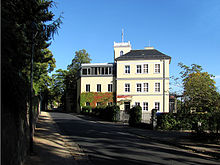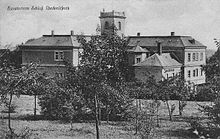"Amalie Sieveking" training center
The former training center "Amalie Sieveking" of the State Association of Inner Mission in the Amalie-Sieveking-Haus building is located in the Niederlößnitz district of the Saxon city of Radebeul , in Obere Bergstrasse 3. The "three-wing complex with tower", which is now a listed building , dates from the 19th century , where it was a sanatorium as a naturopathic facility called “Schloss Niederlössnitz” , which “enjoyed great popularity”. Other names were Sanatorium Castle Niederlössnitz and Wasserheil- and sanatorium "Castle Niederlössnitz" .
description
The three-wing building is located south of the Obere Bergstrasse on a sloping ground to the south. The base of the U-shaped floor plan is in the south, the two wing buildings are oriented towards the street, which they meet at about a 45 ° angle. The entire floor plan is distorted to the west at the base.
The often expanded parts of the building now have three floors. They have flattened, slate-covered hip roofs . The now simply plastered building with rectangular windows is structured by a cornice between the two upper floors.
Both wings encompass an inner courtyard facing the street. A polygonal stair tower stands in the middle in front of the central building . To the left of it rises on the wing structure, towards the inner edge of the building, a square, five-story tower, which is closed off by a crenellated wreath. On the south side of the central building, towards the sloping garden, there are two porch structures.
history

South of the Obere Bergstrasse, west of the “long street”, today's Dr.-Rudolf-Friedrich-Strasse, was a larger vineyard property that was created in 1723 through the merger of several smaller vineyards and extended to the “middle Bergstrasse”, today's Winzerstrasse. The first verifiable owner was the Dresden pharmacist Johann Caspar Birnbaum, after whom the vineyard was sometimes also called Birnbaumscher Weinberg . In 1838 it was named Hoher Berg . As the so-called Herrenberg, the vineyards of this part of the Lößnitz were subordinate to the Dresden office and not to the nearest municipality of Kötzschenbroda . Later owners after Birnbaum were the Senator Wilhelm Heinrich Dittmar in 1822; in 1826 the property belonged to Carl Rudolf Kretzschmar, for 1832 the name Rudolf Kretzschmar is documented, a soap boiler from Dresden.
The core of the current building with a side wing was erected on the vineyard in 1845, possibly by converting an existing vineyard house. The doctor Adolph Moritz Rühlemann had extensions added to this side wing, which may not have been built until 1850. Another source gives the following owner names at that time: 1857: Fr. Wilh. Schmidt, 1858: Traugott Schmidt, brother of the previous one, 1860: Carl Gustav Schloßhauer, soap boiler from Dresden, and for 1870: Mrs. Schloßhauer geb. Mühlberg, widow of the previous owner.
From 1872 or later, the building housed the boys' school with boarding school (later also the higher daughter school) of Dr. Joh. Steinbeck, which was dissolved again in 1884. Before that, the polygonal staircase in the courtyard was built in 1876, followed by the erection of a square tower in 1883. Since the building was previously referred to as the “tower house”, it could have been the conversion or the addition of an existing lower tower.
Carl Richard Friede, a master builder from Dresden, owned the property in 1886. A request to the responsible authorities to run a restaurant there was rejected in 1887.
The property was sold in 1888 to the Berlin merchant Adolph Munk, who was able to obtain the concession for a sanatorium for 35 patients, which was operated from 1889 under the name "Schloss Niederlössnitz". The naturopathic institute for the treatment of the chronically ill had a 6 acre (corresponding to 1.5 hectares), park-like spa garden with air and sunbathing; In addition, numerous naturopathic treatment methods were available to the sanatorium guests, such as water healing methods, electrotherapy, massage, therapeutic gymnastics, as well as dietary, climatic and “terrain cures”. Munk was unable to recruit a well-known doctor as medical director. The first doctor in charge, Max Sartig, was quickly followed by naturopaths Ignatz Böhm, Max Voigt, Georg Beyer, Constantin Hülsmeyer, Hans Brenneke, Ernst Alfred Fichtner and Max Eduard Lähr.
In 1892 Friedrich Ernst Röthe bought the sanatorium. Due to the still great popularity, major structural extensions were made, such as the addition of one floor by the builder Adolf Neumann , which was subsequently approved in October 1897 and increased the capacity to 50 beds. In 1914 the building was further increased. During the First World War, the spa business was banned and the premises served as a “convalescent home for wounded warriors”.
In 1919, the Inner Mission of the Saxon Evangelical Church took over the run-down property in order to run its kindergarten teacher and after-school care center with a housekeeping school . This was previously housed in the Diakonissenanstalt Dresden . To this end, Adolf Neumann's successor, the master builder Felix Sommer , undertook numerous interior alterations until 1921 that did not change the exterior.
After the denominational school was closed by the National Socialists in 1941, the building was used as a retirement home for Baltic German resettlers under the name Lößnitzheim .
From 1946 the Inner Mission school, which was temporarily housed in the Luther House in Kötzschenbroda until 1947 , was named after Amalie Sieveking , the Hamburg co-founder of Diakonie in Germany. From 1947, the bombed-out women's college in Dresden on Kaulbachstrasse was temporarily housed in some of the rooms. In September 1951, the Lößnitzheim nursing home was relocated to Radebeul-Ost, and the Inner Mission was able to use the entire property for the Amalie Sieveking House as a training center for women in the church service - parish helpers and cantor catechists .
During the GDR era, the Amalie Sieveking House was one of only a few “Protestant direct training centers” for training community educators before it was merged with the one in Moritzburg in the early 1990s . The other training centers were the catechetical seminar in Hainstein near Eisenach, the catechetical seminar in Wernigerode, the seminar for church service in Greifswald, the Moritzburg deacon house and the Malche women's mission near Bad Freienwalde .
In 1989 the house received an organ from A. Schuster & Sohn in Zittau.
In 2002 and 2003 a structural and technical renovation took place, which at the same time carried out a monument-compliant as well as a design upgrade of the components in need of renovation.
The property at Obere Bergstrasse 3 belongs together with the property at Obere Bergstrasse 1 to the east; In the villa there is the seat of the Diaconal Work of the Evangelical Lutheran Church of Saxony and the Diaconal Office. The reception and conference building , which was built in 1998/1999 and received the Radebeul Builder Award in 2001 , is located on the border of the two properties, also addressed under No. 1 .
literature
- Frank Andert (Red.): Radebeul City Lexicon . Historical manual for the Loessnitz . Published by the Radebeul City Archives. 2nd, slightly changed edition. City archive, Radebeul 2006, ISBN 3-938460-05-9 .
- Volker Helas (arrangement): City of Radebeul . Ed .: State Office for Monument Preservation Saxony, Large District Town Radebeul (= Monument Topography Federal Republic of Germany . Monuments in Saxony ). SAX-Verlag, Beucha 2007, ISBN 978-3-86729-004-3 .
- Karl Julius: In the sanatorium Schloß Niederlößnitz: a travel memory Karl Julius. Volume 2 of Berlin Brockenhaus-Erzählungen, Frobeen, 1908.
- Sanatorium Schloss Niederlößnitz. In: Marina Lienert, Loschwitz-Wachwitz Local Association (ed.): Naturopathic Dresden. Elbhang-Kurier-Verlag, Dresden 2002, pp. 90–92. ISBN 3-936240-04-3 .
Web links
- Manfred Richter: Niederlößnitz Castle. In: Niederlößnitz from yesteryear. Retrieved on January 19, 2013 (with a contemporary advertising text on equipment features and prices).
- Amalie Sieveking House renovation
- Diaconal work of Ev.-Luth. Regional Church of Saxony
Individual evidence
- ^ Large district town of Radebeul (ed.): Directory of the cultural monuments of the town of Radebeul . Radebeul May 24, 2012, p. 28 (Last list of monuments published by the city of Radebeul. The Lower Monument Protection Authority, which has been based in the Meißen district since 2012, has not yet published a list of monuments for Radebeul).
- ↑ a b c Volker Helas (arrangement): City of Radebeul . Ed .: State Office for Monument Preservation Saxony, Large District Town Radebeul (= Monument Topography Federal Republic of Germany . Monuments in Saxony ). SAX-Verlag, Beucha 2007, ISBN 978-3-86729-004-3 , p. 233 f .
- ↑ Mentioned in: Bäd.-Alm. 7, 1898, p. 505. Quoted from: Hubertus Averbeck: From the cold water cure to physical therapy: considerations about people and the time of the most important developments in the 19th century. Europäische Hochschulverlag, 2012, p. 246. ISBN 978-3-86741-782-2 .
- ↑ Mentioned in: Bäd.-Alm. 4, 1889, pp. 346-347. Quoted from: Hubertus Averbeck: From the cold water cure to physical therapy: reflections on people and at the time of the most important developments in the 19th century. Europäische Hochschulverlag, 2012, p. 508. ISBN 978-3-86741-782-2 .
- ↑ a b c d e f g h i j Manfred Richter: Niederlößnitz Castle. In: Niederlößnitz from yesteryear. Retrieved January 19, 2013 .
- ↑ a b c d Amalie Sieveking House. In: Frank Andert (Red.): Stadtlexikon Radebeul . Historical manual for the Loessnitz . Published by the Radebeul City Archives. 2nd, slightly changed edition. City archive, Radebeul 2006, ISBN 3-938460-05-9 , p. 6th f .
- ↑ Address book Kötzschenbroda with Niederlößnitz and Oberlößnitz, 1880, p. 61.
- ^ Kuranstalt Schloss Niederlößnitz. In: Frank Andert (Red.): Stadtlexikon Radebeul . Historical manual for the Loessnitz . Published by the Radebeul City Archives. 2nd, slightly changed edition. City archive, Radebeul 2006, ISBN 3-938460-05-9 , p. 114 f .
- ↑ Open Monument Day 2006 (Diakonisches Werk) , accessed on January 19, 2013.
- ↑ a b Christoph Führ, Carl-Ludwig Furck: Handbuch der deutschen Bildungsgeschichte . Volume 6, Part 2, C. H. Beck, Munich 1998, p. 64. ISBN 978-3-406-42931-6 . ( Google preview )
- ↑ Faith and life of Diakonie co-founder Amalie Sieveking comes more into focus in the 150th year of death. ( Page no longer available , search in web archives ) Retrieved January 19, 2013.
- ^ Organ directory ( memento of October 9, 2014 in the Internet Archive ), accessed on January 19, 2013.
Coordinates: 51 ° 6 ′ 48 ″ N , 13 ° 38 ′ 58.5 ″ E



